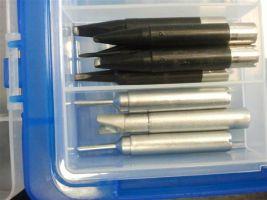Soldering Iron Tip Maintenance

A soldering tip is made of copper which is good heat conductor and it is plated with a very thin layer of iron to avoid copper corrosion. Iron may get oxidized quickly at soldering temperatures and oxidized iron does not conduct heat properly. Hence, iron has to be protected from corrosion and oxidation. In addition, dirt on the tip may cause damages to it at higher temperature and decreases the lifetime of the tip. By following some simple guidelines, you can increase the life time and improve the performance of the soldering iron and tips:
· Ensure that you use a high-quality solder. Impurities on the soldering tip can create difficulties in soldering and heat transfer.
· If you want to clean the iron tips, use a clean sponge which is especially made for soldering. A dirty sponge may create contamination above the tip, this may react and damage the tip at higher temperature.
· Do not use any rough materials to clean a tip, such as emery cloth, scrubber, sandpaper or dry sponge. This takes out the iron from the tip and reduces the life of the tip considerably. Also, avoid dipping your soldering tip in a flux when you clean it, as flux may cause corrosion.
· Do not give more pressure on the tip against a joint. This may result in wear and affect heat transfer.
· It is not advisable to banging the tip on the table to remove excess solder. This may result in breaks on the tips which cause shocks in the iron coating of the tip, as well as damage the soldering iron's heater.
· It is good to avoid striking the tip on the metal holder when you keep the soldering iron in its holder.
· You can make use of a lead based solder if feasible. The proportion of metal elements is high in case of lead free solder and it will make the iron coating of the tip to move towards the solder. This migration and high temperature required for a lead free solder can reduce the life time of the tip by 4 or 5 times when compared to a lead based solder.
· It is a good practice to lower the temperature or turn the iron off, if you do not use the soldering iron for a longer period of time. Keep it on a stable iron stand when it is idle. If you want to store it safely, place it in a zip lock bag once it gets cooled down completely. This will help you in protecting it from humidity and corrosion.
· Always use the lowest temperature possible for soldering, as high temperature may speed up the oxidation process. The appropriate temperature needed for the soldering iron may get varied depending upon the structure of the tip, size of the tip, type and technique of the soldering device and soldering iron.
· It is not recommended to allow the iron at operating temperature for a long time when it not used. This may even burn the element or the iron. Unplug the iron or turn it down to idle setting, if you have a rheostat.
Post Your Ad Here


Comments